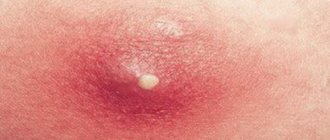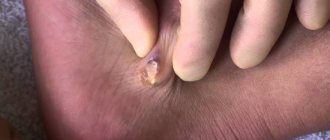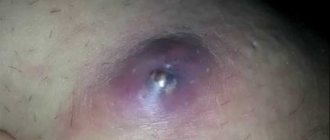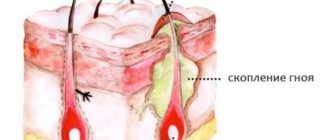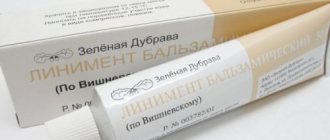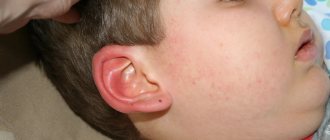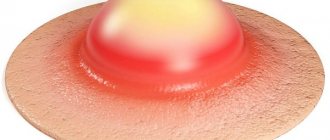How to distinguish a boil from a regular pimple
In most cases, diagnosing a boil is not difficult. Also, due to its characteristic features, it is easy to distinguish it from a simple pimple.
On this topic
- Furuncle
All about the difference between a carbuncle and a boil
- Inna Viktorovna Zhikhoreva
- August 17, 2020
The main features inherent in the inflammatory element:
- formation with a dense infiltrate located deep under the skin;
- large focus of inflammation;
- formation of purulent head in the center;
- excessive pain in the affected area, which increases with mechanical stress.
The boil is characterized by a bacterial etiology of origin. In other words, at the site of formation of the inflammatory focus, active proliferation of pathogenic microorganisms occurs.
Causes
The formation of one boil does not indicate the development of furunculosis. However, in the absence of the necessary measures, the risk of new ulcers increases.
For successful treatment and prevention of subsequent formations, it is necessary to determine exactly what could have triggered the formation of the boil. There may be several reasons:
- Improper compliance with hygiene standards. When the skin is poorly cleansed, pores become clogged. The accumulation of dirt along with the release of sweat and sebum is a favorable environment for the proliferation of pathogenic microorganisms.
- A decrease the immune system, infectious pathologies, and colds are one of the more common causes against which furunculosis appears.
- Disruption of hormonal levels and metabolic processes in the body - a decrease in protective functions contributes to the unhindered penetration of bacteria into the hair follicles.
- Infections – when antibiotic therapy is interrupted, not all bacteria die; some of them remain in the body, which is what provokes the formation of boils.
- Frequent stressful situations.
- Overwork and excessive physical exertion.
- Pathologies of the gastrointestinal tract.
Furunculosis often occurs in alcoholics.
In most cases, ulcers appear on the temples, forehead, upper lip, and nose.
Causes and stages of development of subcutaneous abscess
The cause of an internal boil is infection with Staphylococcus aureus.
The following factors contribute to the development of pathology:
- reduced immunity due to vitamin deficiency, immunodeficiency, or previous illness;
- taking medications that suppress the immune system;
- failure to comply with personal hygiene rules as the cause of a boil;
- violation of the integrity of the skin - cuts, scratches, punctures;
- being in a constant state of stress, excessive emotional stress;
- internal inflammatory processes, tuberculosis, bronchitis, hepatitis, tonsillitis;
- metabolic disorders, diabetes mellitus, obesity, hormonal imbalance;
- excessive sweating;
- abuse of alcohol or sweets;
- severe hypothermia or overheating.
An internal boil, or furuncle, goes through several stages of development:
- Infiltration. An infiltrate is formed under the skin from cellular elements, lymph and blood, the area of which gradually expands, reaching 1.5-4 cm in diameter. The affected tissues swell, become inflamed, redness, soreness, and a local increase in temperature appear.
- Necrotic. After 4-5 days, an abscess forms with a necrotic core in the center. An internal abscess rarely breaks out on its own; surgical intervention is usually required.
- Final. The healing stage is manifested by the proliferation of connective tissue, the formation of a scar at the site of the boil.
The speed of healing depends on the size of the internal formation, the method of opening the abscess, and the state of the immune system.
Symptoms
During the first two days, discharge is observed on the reddened area. A nodule forms in the center, having a black dot at the upper base - accumulated pus.
The shape of the seal resembles a cone and rises slightly above the surface of the skin. If the neck and face area is affected, swelling is observed, the pain increases quickly and has a pulsating or twitching character.
Painful sensations can occur not only during mechanical influence on them, for example, with pressure, or as a result of mobility of the facial muscles, but also as an independent symptom.
On this topic
- Furuncle
How to prevent boils in the ear
- Inna Viktorovna Zhikhoreva
- July 28, 2020
A boil on the face goes through several stages of formation, which is observed over about ten days:
- Infiltration. At this stage, the first three days are marked by severe pain and itching. In the focal area there is pronounced redness. Over time, compaction and swelling begin to appear. There is a rapid increase in education.
- Suppuration. On the fourth day, the formation of a rod occurs - the apex with pus protruding above the skin. As a result of the formation of a necrotic process at the site of inflammation, the pain syndrome decreases, but the patient’s general condition begins to noticeably deteriorate. In some cases, it may be accompanied by an increase in body temperature.
- Break. After the skin above the abscess ruptures, purulent contents are released and the rod comes out. Against this background, the wound is cleansed, which helps reduce pain.
- Healing. When the rod comes out completely, the swelling goes away. A reddish-blue scar appears at the site of the boil. Over time, it fades and becomes less noticeable. It may take some time and effort to get rid of the scar.
On this topic
- Furuncle
All about abscess boils
- Inna Viktorovna Zhikhoreva
- July 28, 2020
A boil on the face can have different sizes. In some cases they can reach the size of a walnut. After healing of such a formation, a scar often remains on the skin, which spoils the appearance of the face.
To correct such a defect, it will be necessary to contact aesthetic medicine specialists. To remove scars, cosmetologists most often offer a method of laser skin resurfacing.
What is a subcutaneous boil and what does it look like?
Subcutaneous boil is a bacterial infection of the hair follicle or sebaceous gland with surrounding soft tissues. The lesion is manifested by dense, lumpy inflammation located in the deep layers of the epidermis. Localization of the internal boil is possible on different parts of the body - on the hips, buttocks, head, face, wherever there is hair, glands and friction occurs.
The lump looks like a pimple, but the boil is larger and looks like a lump; the pus-filled head is often absent.
The main symptom of the disease is severe pain during palpation, with pressure or during movement.
Signs of an internal boil:
- hyperemia, swelling, redness of tissues;
- increased body temperature;
- headache;
- deterioration of health;
- manifestations of general intoxication of the body.
Diagnostics
If signs of inflammation of the skin appear, it is recommended to immediately seek help from a dermatologist. To make an accurate diagnosis, the specialist performs a visual examination and dermatoscopy of the affected area.
To identify the origin of the pathogen, a bacterial culture of the boil discharge is performed.
If the formation of a large number of boils is observed, then additional examinations are prescribed:
- general blood and urine analysis;
- pharyngoscopy;
- rhinoscopy;
- X-ray of the paranasal sinuses;
- fluorography;
- ultrasound examination of the kidneys and abdominal cavity;
- blood sugar test
- bacterial culture of urine.
On this topic
- Furuncle
Let's find out what to do if a lump remains after a boil
- Inna Viktorovna Zhikhoreva
- July 28, 2020
In some situations, additional consultation with a pulmonologist, endocrinologist, otolaryngologist and gastroenterologist may be required.
If complications develop, the following is carried out:
- computed tomography of the kidneys;
- lumbar puncture;
- magnetic resonance imaging of parts of the brain;
- blood culture for sterility.
Also, when carrying out diagnostic measures, there is a need to differentiate furunculosis from diseases such as deep trichophytosis, anthrax, skin tuberculosis, folliculitis.
Treatment
It is necessary to carry out therapeutic measures to eliminate the boil as early as possible. The faster course of its maturation depends on this.
When a boil appears in the facial area, the patient must be hospitalized. All therapeutic procedures should be carried out only under the supervision of a specialist - a surgeon, dermatologist or therapist.
Sometimes the patient may be referred to a dentist, especially if the disease progresses with complications. This is because if treatment is carried out incorrectly, there is a possibility of damage to the facial nerve.
On this topic
- Furuncle
How to prevent boils on your tailbone
- Olga Aleksandrovna Kalinina
- July 11, 2020
The patient must remain in bed during therapy. If the boil is located in the area of the ears, neck or under the chin, the pustular formation should not be allowed to come into contact with clothing.
At the first signs of furunculosis development, it is necessary to treat the inflamed area with antiseptic agents. This will prevent the penetration of new pathogenic bacteria and stop inflammation.
The following drugs are suitable for this purpose:
- hydrogen peroxide;
- furatsilin;
- salicylic alcohol.
When wiping the skin, it is not recommended to rub the boil itself. Disinfection is carried out several times a day. You should also avoid touching the abscess with your hands.
To speed up the maturation process, compresses with Vishnevsky ointment are prescribed. The drug has an unpleasant odor, so it is better to carry out the procedure before bed.
A gauze cloth should be soaked in ointment and secured at the site of the inflammatory lesion with an adhesive plaster. In most cases, one or two such compresses are enough, after which the boil opens.
On this topic
- Furuncle
Find out which doctor to contact with a boil
- Olga Aleksandrovna Kalinina
- June 24, 2020
After the release of necrotic masses occurs, the doctor also recommends antimicrobial treatment. It is also recommended to use ichthyol ointment, which helps draw out the remaining purulent contents and speeds up the healing process. For maximum results, use Levomycetin and Tetracycline in the form of ointments.
If multiple formation of boils is noted on the face, the specialist prescribes antibiotic therapy. In this case, 3 groups of funds can be used:
- Penicillins (Amoxicillin, Amoxiclav);
- Macrolides (Azithromycin, Erythromycin and others);
- Cephalosporins (Cefazolin, Cefotaxime).
The choice of one or another remedy is made based on the results of tests performed by a doctor to determine the type of pathogen. In addition, it is necessary to take into account the body’s sensitivity to antibiotics of certain groups. At a high level, treatment will be more effective.
Physiotherapy
To disinfect the area around the boil, accelerate tissue regeneration and the process of abscess maturation, an electric field and ultraviolet irradiation can be prescribed.
The procedures are painless, prevent an increase in the inflammatory process and relieve pain.
Physiotherapy is suitable for all stages of boil formation.
To increase the body's resistance, ozone therapy is prescribed, as a result of which the tissues are saturated with oxygen, which stimulates the immune and barrier functions of the skin.
Surgery
When physical therapy does not lead to positive results, the boil is removed surgically. The following methods of opening a boil are distinguished:
- Laser burning of the rod is one of the safest procedures, after which there are no scars on the face or marks on the skin. Wound healing occurs painlessly within a short period of time. The process does not require daily dressings.
- Scalpel dissection of tissue. Surgical treatment with this method is necessary in cases where there is an abundant accumulation of purulent contents. The affected area is treated with an anesthetic before surgery. The abscess is cut and the pus is squeezed out. After this, the wound is expanded and cleaned of residual fluid. Next, they are treated with an antiseptic and dressings are made for 10 days.
For faster wound healing, you can also use Vishnevsky ointment.
Treatment methods
Need advice from an experienced doctor?
Get a doctor's consultation online. Ask your question right now.
Ask a free question
Treatment of a subcutaneous boil is prescribed by a surgeon or dermatologist after a complete diagnosis. The study includes anamnesis, examination of the affected area, dermatoscopy, clinical and biochemical blood tests. Based on the results, the specialist prescribes treatment that accelerates the maturation of the internal abscess, its breakthrough, and healing.
Doctors do not recommend self-medication or opening a benign formation. Carrying out the procedure without the appropriate skills or with unsterile instruments risks infection of healthy tissue near the boil and the development of serious complications.
Ointments and compresses for drawing out pus
Ointments will help to effectively cope with internal subcutaneous boils and speed up their opening: ichthyol, Levomekol, Vishnevsky liniment, Gepar-Sulfur.
Procedure for using the funds:
- Disinfect the skin around the internal boil well with medical alcohol, Chlorhexidine or hydrogen peroxide.
- Apply a thin layer of ointment to the affected area, cover with a gauze bandage.
- Apply a compress with dry heat to the boil - you can use a bag of salt - and leave for 10-20 minutes.
- Repeat the procedure twice a day until the abscess breaks through.
To relieve pain from internal formation and relieve itching, apply compresses with salicylic or camphor solution, tincture of iodine, bergamot or chamomile oil to the area of the boil at night.
Surgical intervention
If the closed abscess increases significantly and symptoms of intoxication appear, the patient is hospitalized for surgery.
The procedure for removing an internal boil:
- The affected area is treated with local antiseptic agents. Local anesthesia is administered.
- The surgeon opens the boil with a scalpel or laser, removes the purulent-necrotic core, then rinses the cavity with antiseptics. If necessary, drainage is installed.
- An aseptic bandage impregnated with antibiotics is applied to the boil, which should be changed every 6-8 hours.
- To prevent secondary infection, the patient is prescribed broad-spectrum antibacterial drugs.
Postoperative recovery after a boil is carried out under the supervision of a doctor who monitors the wound healing process to avoid complications. To accelerate wound scarring, competent care, UHF therapy, vitamin and mineral complexes and immunostimulating drugs for internal use are prescribed.
ethnoscience
Traditional medicine will help speed up recovery.
Popular recipes for treating internal abscess:
- cut the peeled onion in half, bake in the oven, and apply it to the boil while still warm;
- cut an aloe or Kalanchoe leaf lengthwise, apply the cut to the abscess, bandage it, wrap it in plastic;
- Form a cake from equal proportions of flour and honey, apply it to the area of internal damage, leave overnight;
- soak a cotton swab or compress in heated alcohol and apply to the wound;
- grate the raw onion on a coarse grater, combine with baked milk, apply a compress to the boil to draw out the pus;
- lubricate the boil with plantain or coltsfoot juice to speed up ripening;
- treat the new growth with a decoction or tincture of calendula to stimulate maturation and breakthrough of the stem;
- Combine grated laundry soap with baked onions, mix well, apply to the boil.
Folk remedy for rapid wound healing and normalization of processes in internal tissues:
- Add 10 g of propolis to 50 g of animal fat.
- Heat the mixture in a water bath for 60-90 minutes to completely dissolve and combine the components.
- Apply homemade ointment to the internal abscess twice a day.
Before using traditional medicine, consult your doctor, make sure there are no allergic reactions and individual contraindications to the chosen method of treating a boil.
Prevention
To prevent the appearance of boils on the face, you must follow some rules:
- do not expose the skin to overheating or hypothermia;
- strengthen the immune system;
- do not drink alcoholic beverages;
- stop smoking;
- Healthy food;
- spend more time outdoors .
On this topic
- Furuncle
Should you take boils on your head seriously?
- Irina Nasredinovna Nachoeva
- April 10, 2020
Furunculosis on the face is a skin disease that can pose a serious threat to human health. It must be taken seriously.
Even if a single abscess appears, it is recommended to consult a specialist who will prescribe the necessary treatment. Under no circumstances should you squeeze boils yourself. This can lead to unpleasant consequences.
